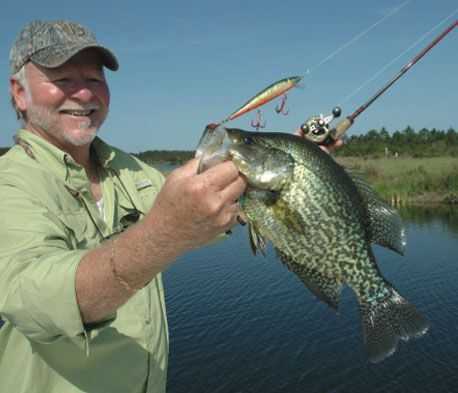During Northeast Florida’s winter fishing season bait shop sales for live crappie baits often exceed sales for live bass minnows. In fact many of Northeast Florida freshwater lakes will experience more fishing activity for crappie rather than Florida’s number one freshwater game fish, the “Bigmouth” bass. During a past winter fishing trip to the Harris Chain of Lakes I motored from Big Lake Harris into the “Dead River” and counted over fifty crappie fishing boats anchored up and fishing the deep edges of a mix of lily pads and hydrila.
The cooler water temperatures of Florida’s winter fishing season promotes a huge largemouth bass and black crappie migration from shallow water to nearby deep water structures. Without saying the best crappie and bass fishing action comes during the cooler months of winter where both species tend to bunch up along deep edges of aquatic weeds, ledges, boat docks and submerged brush.
A good knowledge of fish finders is a huge aid in hooking up with some of Northeast Florida’s best winter crappie and bass fishing action. Here fishermen often prefer a combo GPS/Sonar unit where the screen shows both navigation and structure. Once a productive winter fishing location is located, the location can be logged into the unit and revisited easily during future fishing trips. More importantly when you locate a school of black crappie, you will be able to record such information as water temperature, water depth, water clarity and type of structure that the crappie are holding too. Finding similar situations in the same body of water is a great aid in catching crappie when your present crappie fishing waters produce little action.
A deadly fishing tactic for both locating schooling black crappie and catching them too, is employing a slow drift along a deep water edge while monitoring your fish finder This can be accomplished if the wind is blowing perfectly parallel to the deep water weed line allowing your crappie skiff to drift slowly along the weed edge. If the wind is dead calm, a bow or transom mounted electric trolling motor will navigate your fishing boat slowly over prime deep water crappie structure.
Without saying Missouri minnows are by far the #1 crappie bait. However casting a Missouri minnows are barbed from the bottom and right through the top of the mouth with a #4-#6 wire hook. The wire hook allows the minnow to swim lively along the deep edge. Pinch a tiny split shot a foot above the hook onto to 8-10 pound monofilament fishing line so that the live minnow swims deep. Other prime black crappie baits include worms and crickets.
Crappie artificial lures include beetle spins, small plastic tail jigs and rooster tails in the 1/32 to 1/16 ounce size. However some of the largest black crappie caught are
often taken by bass fishermen casting small minnow type plugs liken the black and silver Rapala.
Once a crappie or two has been caught, be ready to anchor your fishing boat close to a hopeful school of Northeast Florida black crappie. Once anchored attach a small torpedo float on to your terminal fishing line which is adjusted so that the minnow swims just off from the bottom and close to the deep weed line.
Florida winter largemouth bass can be located using almost the very same fishing tactic that is used for locating schooling crappie. Here largemouth bass will also migrate from their spring, summer and fall shallow water habitat to the edges of deep water structures. If there are submerged deep water weed beds located just offshore of shallow water weed beds, this type of deep water weed bed can be a huge magnet for winter bass.
During a past winter bass fishing trip to Florida’s Rodman Reservoir, we used our Lowrance GPS/Sonar unit to locate a deep water weed bed that produced winter largemouth bass to 12-pounds. During cloudy periods of the day, the deep water bass would move out of the 20-foot drop and re-locate over a 5-6 foot flat. While during sunny periods of the day the bass would re-visit the deep weed bed.
Our lures of choice were large live shiners free lined from our anchored bass boat into the deep weed bed without a float and barbed to 20-pound bass tackle using a 5/0 weedless kahle hook. The kahle hook was barbed just behind the anal fin which promoted the shiner to swim deep. During cloudy portions of the day we would drift over the nearby weedy flat while barbing our live shiners from the bottom of the mouth right through the top of the mouth.
Our lure of choice was a #11 silver and black Rapala which we made long casts with 10-15 pound spin tackle to floating stumps and logs that harbored large weed beds close by.
Finally simply every Northeast Florida Lake and river that harbors largemouth bass will more than likely have a nice stock of black crappie as well. Both popular freshwater game fish find their winter Holmes where deep water and a shallow water structure make for both a comfort zone and ambush point for winter bass and crappie. Look for the best winter bass and crappie fishing to come during long periods of stable weather and a few days before a full moon. The current daily bag limit for black crappie is 25-per day. The current bag limit for largemouth bass is 5-per day measuring at least 14-inches with one bass measuring over 22-inches. For more information, visit www.myfwc.com.

